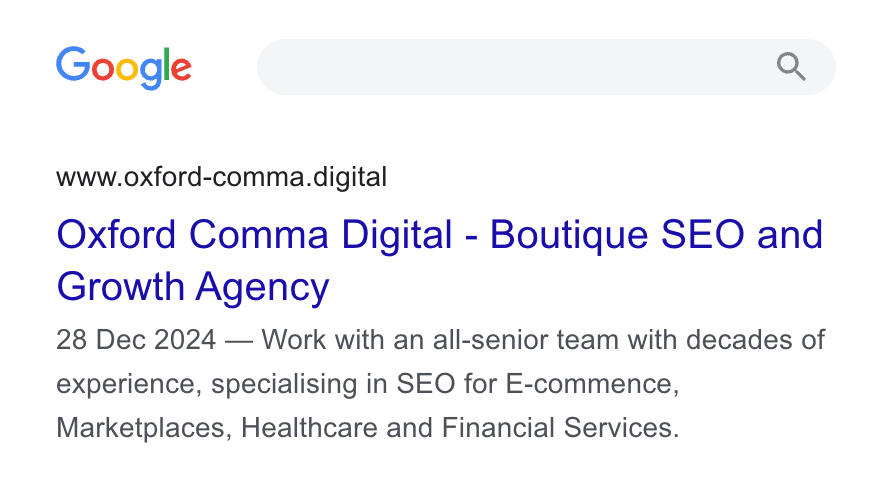The Ultimate Guide for E-commerce Meta Descriptions

Hello and welcome to our ultimate guide on meta descriptions for e-commerce websites! Together we’ll explore how best to write a great meta description for your e-commerce store. But first things first…
What is a meta description?
If you read our ultimate guide to e-commerce page titles, you might remember our example. It looked like this:

Well, the meta description is displayed right below the page title.
In the ultimate guide to page titles, we also went through other places you can see them, however, meta descriptions are only displayed in search engine results pages (SERPs) and sometimes when you share the page on social media.
Like with anything else on a website, it’s ultimately a piece of code and if you’re using a content management system like Shopify or BigCommerce, then you’ll have an input field where you can edit this content.
Why are meta descriptions important?
Previously, your page title and description were “ranking factors”, as in, if you were to add your target keyword within the meta description your site was more likely to rank for that keyword, however, that’s no longer the case. Though your page title is a tiny ranking factor and your meta description isn’t a ranking factor, they can both dramatically impact click-through rates, which is a massive factor in how much traffic you can get to your site.
Meta descriptions are a great way to expand on what people might find if they do click on your site. A lot of factors can impact whether or not someone clicks onto your site or not, from the correct search intent to brand recognition and by making use of the space available to you in search engine results pages (SERPs), you can help to influence that decision.
Why aren't meta descriptions important?
This probably isn't a heading you were expecting in an SEO blog, huh? Ultimately, meta descriptions do matter, as I said above, they can impact click-through rates. However, the meta description is less visible than the title, as most internet users skim the SERP. Furthermore, Google will rewrite a lot of meta descriptions to include text that they deem more relevant to the search query. There’s a section below that delves into title length and how Google has changed the guidelines a bit over the years and to that I say “that’s ok”. There’s no big rush to change your meta descriptions to cater to any new guidelines, since they might do what they did before and change them back and they might be overwriting your descriptions anyway. Essentially, sometimes it’s worth investing in getting your meta descriptions totally right and sometimes you could put your time somewhere else to have a greater impact.
What are the best practices for meta descriptions?
Taking e-commerce out of the picture for a moment, there are some general best practices on how to best optimise your meta descriptions.
Ensure your description is 150-160 characters in length
You’ll want your meta description to be between 150-160 characters in length or around 430-920 pixels. Google has experimented with the lengths of meta descriptions in the past. In Dec 2017, Google changed the character length to 320 characters, nearly twice as long! However, they reversed the decision not too long after, bringing character limits back down to 160. Google might experiment again in the future but, for now, 160 is the cap.
How to create a great meta description for e-commerce:
The above were general best practices for any site. The following are more specific to e-commerce sites.
Mirror the language of your audience
I like to recommend mirroring the language of your users for e-commerce stores (I wouldn’t recommend this for all niches) because sometimes people will use a colloquial term for a product or use case instead of a technical term. Or if they have questions, you can directly mirror that so they can instantly see from SERPs that you’re about to answer their question. For example, you could mirror their exact question with the page title and then start to answer it with the meta description. As long as you leave enough out so that they’ll need to click on your site to get the full answer.
Add a unique selling point
The meta description is a great place to add your USP. We recommended adding this to your page title, however, due to the shorter character limits for titles, sometimes it has to go into your description. This is a great place to put something like free shipping options, or, if you update your descriptions regularly, you can add sales messaging.
Emotive
Triggering an emotion is a great way to get someone to click on your site. This doesn’t have to be a strong emotion like anger or adoration, but a more subtle emotive message. The automotive industry does this really well.

In this example, both the title and description are emotive. With phrases like “drive your ambition” and “peace of mind”, they’re clearly playing to people’s emotions.
Another example of an industry that plays on emotions in their meta descriptions is fragrance. The titles are typically pretty standard in SERPs as they’re sold from multiple large retailers, who are likely relying on a schema, however, because the meta descriptions are used to describe the fragrance and the organisations developing the fragrance want to evoke a mood, a feeling or even help to create a persona of the wearer, the descriptions typically play into this. For example:

Here you can see the title is just the name of the product, but the description evokes a “mystical power”.
So the automotive and fragrance industries are excellent examples where the emotive element is very evident and this stems from their overall branding. If this is the case with you’re brand it would make a lot of sense to bring this out into the SERP to hopefully get that click!
This has been your ultimate guide to meta descriptions, if you’re curious about how to optimise your e-commerce site for organic traffic, take a look at our ultimate guide to e-commerce page titles.

